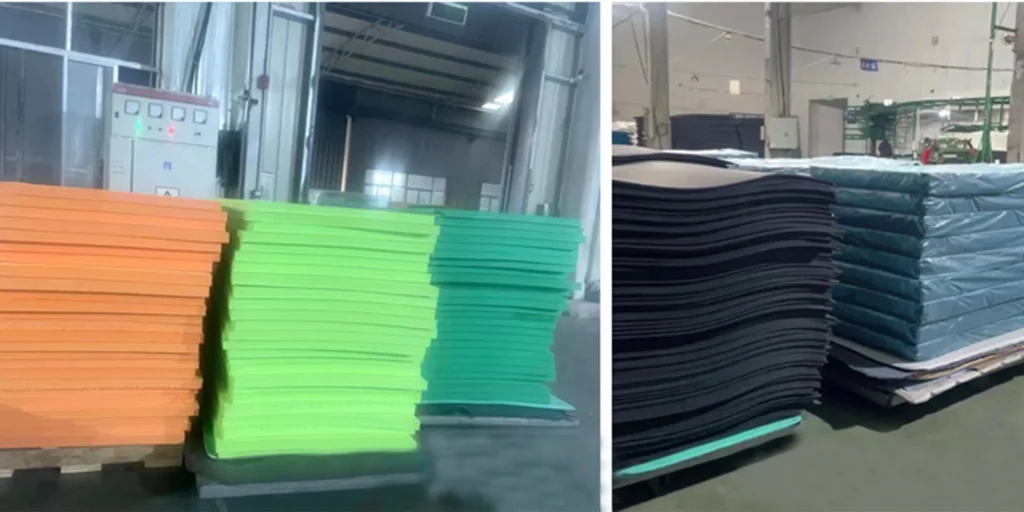EVA foam, short for ethylene-vinyl acetate, is a versatile material widely used in a variety of industries, including footwear, sports equipment, toys, construction, and automotive products. Known for its lightweight, durable, and shock-absorbing properties, EVA foam has grown in popularity as a go-to material for padding, insulation, and protective applications. However, as global environmental consciousness increases, questions arise regarding EVA foam’s environmental impact and its role in sustainability efforts.
In this article, we will explore what EVA foam is, examine its environmental effects, and evaluate its sustainability potential. This guide is intended to provide a comprehensive understanding of the material, along with insights into how businesses and consumers can make informed, eco-conscious decisions.
What Is EVA Foam?
EVA foam is a copolymer of ethylene and vinyl acetate. It is known for its flexibility, resilience, and ability to retain its shape even after repeated compressions. These qualities make EVA foam an excellent material for many everyday products, such as:
- Footwear: Used in midsoles and insoles of athletic shoes to provide cushioning and impact absorption.
- Sports Equipment: EVA foam is commonly found in helmets, kneepads, and other protective gear.
- Toys and Craft Supplies: Lightweight and easy to mold, EVA foam is a staple in the creation of children’s toys, mats, and DIY crafts.
- Construction and Insulation: EVA foam is used for shock absorption, weatherproofing, and sound insulation in construction materials.
Despite its usefulness, the production and disposal of EVA foam raise concerns about its environmental footprint.
Environmental Impact of EVA Foam
1. Production Process
The manufacturing of EVA foam involves petrochemicals, specifically ethylene, which is derived from crude oil. The production process can contribute to carbon emissions and environmental degradation. Additionally, the use of vinyl acetate, which can be toxic in large quantities, has raised concerns about worker safety and air pollution.
While EVA foam is not inherently harmful, the sourcing of its raw materials is a key factor in determining its overall environmental impact.
2. Non-Biodegradable Nature
One of the primary criticisms of EVA foam is that it is non-biodegradable. Once discarded, EVA foam products can persist in the environment for many years, contributing to landfill waste and environmental pollution. The material’s resistance to decomposition makes it difficult to manage in the context of a sustainable, circular economy.
3. Recyclability
EVA foam is somewhat challenging to recycle due to its unique composition. While some specialized facilities can process EVA foam, most municipalities do not have the infrastructure to handle its recycling efficiently. As a result, much of the discarded EVA foam ends up in landfills. However, advancements in technology have made strides toward improving EVA foam recycling processes.
4. Microplastic Concerns
Like many synthetic materials, EVA foam can break down into smaller particles over time, contributing to the global microplastic problem. These tiny particles can enter waterways, soil, and even the food chain, posing potential risks to both wildlife and human health.
Is EVA Foam Sustainable?
In light of the environmental challenges associated with EVA foam, it’s essential to consider whether it can be part of a more sustainable future. Here are some factors to consider:
1. Durability and Longevity
One of the positive aspects of EVA foam is its durability. Products made from EVA foam tend to have a long lifespan, which means they do not need to be replaced frequently. This durability can help reduce waste, as fewer products are discarded over time. In sectors like footwear, sports, and construction, the longevity of EVA foam products helps mitigate their environmental impact by reducing the frequency of replacements.
2. Recycling Initiatives
In recent years, there has been a push to improve the recyclability of EVA foam. Some manufacturers are exploring innovative ways to recycle EVA foam products into new materials. For example, EVA foam from used shoes can be processed and repurposed for new footwear or other applications. The rise of circular economy models in the manufacturing industry offers hope for reducing the environmental burden of EVA foam waste.
3. Eco-Friendly Alternatives
In response to increasing environmental concerns, manufacturers are exploring alternatives to traditional EVA foam. Some are developing bio-based EVA foam, which incorporates plant-based materials in place of petrochemicals. These eco-friendly alternatives seek to maintain the beneficial properties of EVA foam while reducing its environmental footprint.
For businesses looking to make more sustainable choices, partnering with manufacturers that prioritize environmentally friendly production processes and materials can be an effective strategy.
4. Sustainable Product Design
Designing products with sustainability in mind can also help mitigate the environmental impact of EVA foam. This includes creating products that are easy to disassemble for recycling, using less material, and designing for durability and repairability.
Additionally, businesses can educate consumers on the importance of responsible product disposal, encouraging them to recycle whenever possible or donate old products for reuse.
Ways to Minimize EVA Foam’s Environmental Impact
Although EVA foam poses some environmental challenges, there are steps businesses and consumers can take to minimize its impact:
1. Prioritize Recycling
As more recycling options become available, it’s important to prioritize the recycling of EVA foam products when they reach the end of their useful life. Consumers can research local recycling facilities and programs that accept EVA foam.
2. Support Sustainable Manufacturers
Consumers can seek out companies that are actively working to reduce their environmental footprint by using recycled materials, minimizing waste, and implementing eco-friendly production methods.
3. Consider Alternatives
In applications where EVA foam is not essential, consider using alternative materials that are more environmentally friendly. Materials like cork, natural rubber, or biodegradable foams may offer comparable performance while having a lesser environmental impact.
4. Educate and Advocate
Both businesses and consumers can play a role in advocating for better recycling programs and policies. Governments and organizations can be encouraged to invest in the infrastructure needed to recycle EVA foam more efficiently.
EVA foam, while a highly functional material with numerous applications, presents several environmental challenges that must be addressed. From its petrochemical origins to its non-biodegradability and recycling difficulties, EVA foam has room for improvement when it comes to sustainability.
However, there is hope on the horizon. As industries embrace circular economy principles, develop eco-friendly alternatives, and improve recycling processes, EVA foam’s environmental impact can be minimized. Consumers and businesses alike can contribute to this movement by making informed, responsible choices about the materials they use and dispose of.
In summary, while EVA foam is not currently the most environmentally friendly option, efforts to increase its sustainability are growing. Through innovation and conscious decision-making, EVA foam has the potential to play a role in a more sustainable future.
FAQ Section
1. What is EVA foam?
EVA foam (ethylene-vinyl acetate) is a lightweight, flexible, and durable material used in various industries, including footwear, sports equipment, toys, and construction. It is known for its shock-absorbing and insulating properties.
2. Is EVA foam environmentally friendly?
EVA foam presents environmental challenges due to its non-biodegradable nature and reliance on petrochemicals. However, efforts are being made to improve its sustainability through recycling initiatives and the development of eco-friendly alternatives.
3. Can EVA foam be recycled?
While EVA foam is difficult to recycle, advancements in recycling technology are making it possible to repurpose EVA foam products. However, many municipalities lack the infrastructure to recycle it efficiently.
4. What are some eco-friendly alternatives to EVA foam?
Eco-friendly alternatives to EVA foam include bio-based EVA, which uses plant-based materials, and other sustainable options like natural rubber, cork, and biodegradable foams.
5. How can I reduce the environmental impact of EVA foam?
To minimize the environmental impact of EVA foam, consumers can prioritize recycling, support sustainable manufacturers, consider using alternative materials, and advocate for better recycling programs and policies.
#EVAfoam #Sustainability #EcoFriendlyMaterials #Recycling #EnvironmentalImpact #GreenManufacturing #SustainableFuture #EcoConscious #ZeroWaste #EcoAlternatives
WELLE Trade has over 20 years of experience in the production and processing of PE/EVA/TPE foams, so you may want to consult with them if you have any sourcing needs.




